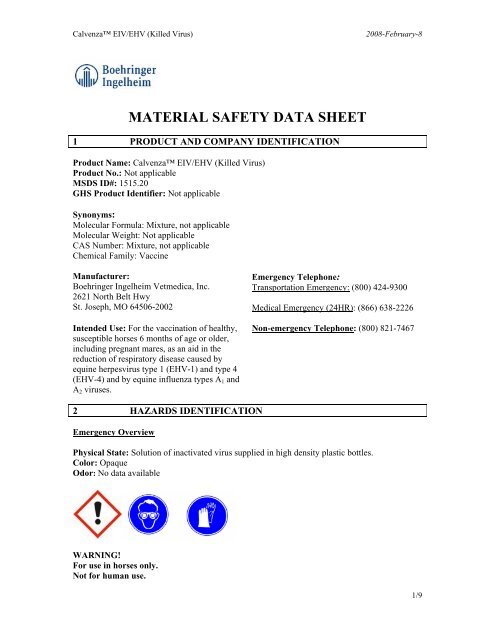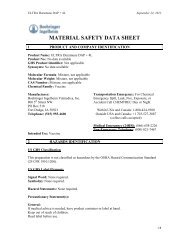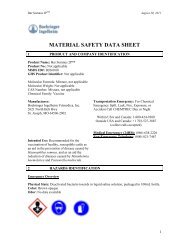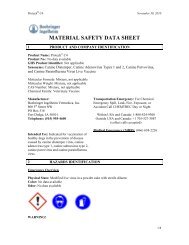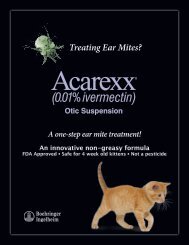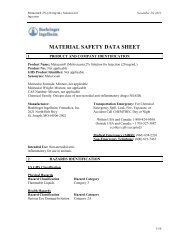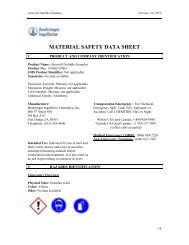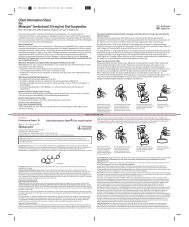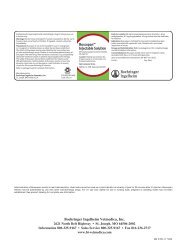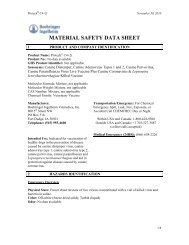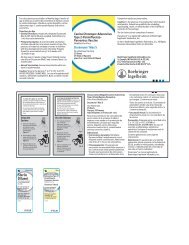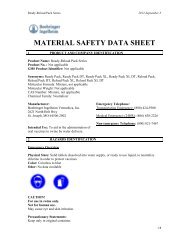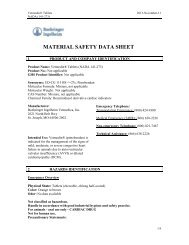Calvenza⢠EIV/EHV - Boehringer Ingelheim Vetmedica
Calvenza⢠EIV/EHV - Boehringer Ingelheim Vetmedica
Calvenza⢠EIV/EHV - Boehringer Ingelheim Vetmedica
You also want an ePaper? Increase the reach of your titles
YUMPU automatically turns print PDFs into web optimized ePapers that Google loves.
Calvenza <strong>EIV</strong>/<strong>EHV</strong> (Killed Virus)2008-February-8MATERIAL SAFETY DATA SHEET1 PRODUCT AND COMPANY IDENTIFICATIONProduct Name: Calvenza <strong>EIV</strong>/<strong>EHV</strong> (Killed Virus)Product No.: Not applicableMSDS ID#: 1515.20GHS Product Identifier: Not applicableSynonyms:Molecular Formula: Mixture, not applicableMolecular Weight: Not applicableCAS Number: Mixture, not applicableChemical Family: VaccineManufacturer:<strong>Boehringer</strong> <strong>Ingelheim</strong> <strong>Vetmedica</strong>, Inc.2621 North Belt HwySt. Joseph, MO 64506-2002Intended Use: For the vaccination of healthy,susceptible horses 6 months of age or older,including pregnant mares, as an aid in thereduction of respiratory disease caused byequine herpesvirus type 1 (<strong>EHV</strong>-1) and type 4(<strong>EHV</strong>-4) and by equine influenza types A 1 andA 2 viruses.Emergency Telephone:Transportation Emergency: (800) 424-9300Medical Emergency (24HR): (866) 638-2226Non-emergency Telephone: (800) 821-74672 HAZARDS IDENTIFICATIONEmergency OverviewPhysical State: Solution of inactivated virus supplied in high density plastic bottles.Color: OpaqueOdor: No data availableWARNING!For use in horses only.Not for human use.1/9
Calvenza <strong>EIV</strong>/<strong>EHV</strong> (Killed Virus)2008-February-8Allergic reactions can occur.Precautionary Statements:Accidental human injection may cause serious local reactions or anaphylactic reaction andsystemic effects.Keep only in original container.Keep at a temperature between 2 - 7° C.Do not freeze.Fire-fighting: Use foam, carbon dioxide, dry powder and water fog or material appropriate forsurrounding fire.Avoid contact with eyes, skin and clothing.Wash thoroughly with soap and water after handling.Wear suitable gloves and eye/face protection.Spills: Cover with absorbent or contain. Collect and incinerate.In case of accident or if you feel unwell, seek medical advice immediately (show the label wherepossible).Have the product container or label with you when calling a poison control center or doctor, orgoing for treatment.If swallowed, seek medical advice immediately and show this container or label.This material and its container must be disposed of in a safe way.Keep out of reach of children.Keep away from food, drink, and animal feedstuffs.Description: Recommended for the vaccination of healthy, susceptible horses 6 months of age orolder, including pregnant mares, as an aid in the reduction of respiratory disease caused by equineherpesvirus type 1 (<strong>EHV</strong>-1) and type 4 (<strong>EHV</strong>-4) and by equine influenza types A 1 and A 2 viruses.Shake well before use. Use entire contents when first opened. Using aseptic technique, inoculatehorses intramuscularly with a 2 mL dose. Administer a second 2 mL dose intramuscularly in 3-4weeks using a different injection site. Administer a third 2 mL dose in 3-4 weeks by either theintramuscular or intranasal route. Revaccinate annually and prior to anticipated exposure, byeither the intramuscular or intranasal route.Acute effect: Rarely, severe allergic reactions may occur that require immediate veterinary care.Antidote: Epinephrine.Precautions/Contraindications: Do not vaccinate within 21 days before slaughter.Overdosage: None known.ADVERSE REACTIONS TO PRODUCT: Anaphylactoid reactions may occur following use.Potential Health EffectsInhalation: Not expected to be an inhalation hazard with prescribed use.Eye Contact: Not expected to be a hazard to the eye with prescribed use. Exposure to liquid ineye may cause mild transient eye irritation.Skin Contact: Not expected to be a hazard to the skin. Can cause hypersensitive reactions. Maycause skin sensitization by contact.2/9
Calvenza <strong>EIV</strong>/<strong>EHV</strong> (Killed Virus)2008-February-8Ingestion: Not expected to be an ingestion hazard with prescribed use. Ingestion may causenausea and systemic effects.Injection: Swelling at injection site may occur.Chronic Health Effects: Possible hypersensitization (development of abnormal sensitivity).Target Organ(s): Cardiovascular system, respiratory system, skinPotential Physical Effects: Can cause skin sensitization.OSHA Regulatory Status: NonhazardousEnvironment: No data available3 COMPOSITION / INFORMATION ON INGREDIENTSChemical Name EC No. CAS- No. Concentration Classification NotesInactivated equine ---- ---- proprietary ---- ---influenza virusInactivated equine ---- ---- proprietary ---- ---herpesvirusGentamicin ---- ---- proprietary ---- ---Thimerosal(merthiolate)---- 54-64-8 < 0.01 T+; NR26/27/28, R33,R50/53---The full texts for all R-Phrases are displayed in Section 16, if applicable.4 FIRST AID MEASURESGeneral: Animals or persons developing anaphylactic (life-threatening) reactions, such asdifficulty in breathing or unconsciousness, must receive immediate medical attention.Inhalation: Move to fresh air. Treat symptomatically. Get medical attention if symptoms persist.Eye Contact: Any material that contacts the eye should be washed out immediately with water. Ifeasy to do, remove contact lenses. Get medical attention if symptoms persist.Skin Contact: In case of contact, immediately flush skin with plenty of water for at least 15minutes while removing contaminated clothing and shoes. If skin irritation or rash occurs, seekmedical advice. Wash contaminated clothing before reuse.Ingestion: Call a physician or poison control center immediately. Only induce vomiting at theinstruction of medical personnel. Never give anything by mouth to an unconscious person.Injection: In case of accidental injection, wash the site thoroughly. Contact a physicianimmediately.3/9
Calvenza <strong>EIV</strong>/<strong>EHV</strong> (Killed Virus)2008-February-8Note to Physician: For use in horses only. Not for human use. Status of immunization should bereviewed. Emergency procedures should be symptomatic and supportive.Antidote: Epinephrine is indicated for anaphylactoid reactions.5 FIRE-FIGHTING MEASURESExtinguishing Media: Extinguish with foam, carbon dioxide, dry powder and water fog ormaterial appropriate for surrounding fire.Unsuitable Extinguishing Media: None knownSpecial Fire Fighting Procedures: Wear self-contained breathing apparatus and protectiveclothing.Unusual Fire & Explosion Hazards: None knownHazardous Combustion Products: Carbon monoxide, carbon dioxide, mercuryFlammability Class: 06 ACCIDENTAL RELEASE MEASURESPersonal Precautions: Wear appropriate personal protective equipment (See Section 8).Spill Cleanup Methods: Small liquid spill: Use a non-combustible material like vermiculite,earth or sand to soak up the product and place into container for later disposal. Incinerate. Forlarge liquid spill: Absorb or cover with dry earth, sand or other non-combustible material andtransfer to containers. Incinerate.Environmental Precautions: Prevent runoff from entering drains, sewers or streams. Dike forlater disposal.7 HANDLING AND STORAGEHandling: Avoid contact with eyes, skin and clothing. Avoid accidental injection. Washthoroughly with soap and water after handling. Use only with adequate ventilation.Storage: Store at 2°-7° C (35°-45° F). Do not freeze. Shake well before using.8 EXPOSURE CONTROLS / PERSONAL PROTECTIONFor Industrial Exposures:Exposure Limits: None established.Engineering Controls: Not generally required when handling vials or containers. Goodventilation (typically 10 air changes per hour) should be used. Ventilation rates should bematched to conditions. If applicable, use process enclosures, local exhaust ventilation, or otherengineering controls to maintain airborne levels below recommended exposure limits. If exposurelimits have not been established, maintain airborne levels to an acceptable level.4/9
Calvenza <strong>EIV</strong>/<strong>EHV</strong> (Killed Virus)2008-February-8Respiratory Protection: Not generally required when handling vials or containers. Ifengineering controls do not maintain airborne concentrations below recommended exposurelimits (where applicable) or to an acceptable level (in countries where exposure limits have notbeen established), an approved respirator must be worn. In the United States of America, ifrespirators are used, a program should be instituted to assure compliance with OSHA standard 63FR 1152, January 8, 1998. Respirator type: Air-purifying respirator with an appropriate,government approved (where applicable), air-purifying filter, cartridge or canister. Contacthealth and safety professional or manufacturer for specific information.Europe: Wear appropriate personal protective equipment according to the CouncilDirective 89/686/EEC (4) and the appropriate CEN standards.PERSONAL PROTECTIVE EQUIPMENT: Not generally required when handling containers.If containers are compromised or exposure to the active ingredient or mixture is likely wear:Eye Protection: Wear safety glasses with side shields (or goggles).Hand Protection: Wear suitable gloves.Skin Protection: Wear protective clothing appropriate for the risk of exposure.Hygiene Measures: Eye bath, washing facilities, shower9 PHYSICAL AND CHEMICAL PROPERTIESColor: OpaqueOdor: No data availableOdor Threshold: No data availablePhysical State: Solution of inactivated virus supplied in high density plastic bottles.pH: No data availableMelting Point: No data availableFreezing Point: No data availableBoiling Point: No data availableFlash Point: No data availableFlammability Limit – Upper (%): No data availableFlammability Limit – Lower (%): No data availableEvaporation rate: No data availableVapor Pressure: No data availableVapor Density (Air=1): No data availableSpecific Gravity: No data availableSolubility: No data availablePartition Coefficient (n-Octanol/water): No data availableAutoignition Temperature: Not applicableDecomposition Temperature: No data available10 STABILITY AND REACTIVITYStability: StableConditions to Avoid: Temperatures below 2° C (35° F)5/9
Calvenza <strong>EIV</strong>/<strong>EHV</strong> (Killed Virus)2008-February-8Incompatible Materials: Strong oxidizing agentsHazardous Decomposition Products: None knownPossibility of Hazardous Reactions: Will not occur.11 TOXICOLOGICAL INFORMATIONCalvenza <strong>EIV</strong>/<strong>EHV</strong> (Killed Virus) is considered nontoxic.Listed Carcinogens: None12 ECOLOGICAL INFORMATIONEcotoxicity: No data availablePersistence and degradability: No data availableMobility in soil: No data availableOther adverse effects: No data availableGermany WGK: Not applicable13 DISPOSAL CONSIDERATIONSGeneral Information: Dispose of in accordance with local, state, federal, national orinternational regulations.Disposal Methods: Incinerate containers and unused contents. Do not empty into drains; disposeof this material and its container in a safe way. Do not contaminate water, food, or feed bydisposal.RCRA Information: Not applicable14 TRANSPORT INFORMATIONDOT: Not regulatedTDG: Not regulatedADR/RID: Not regulatedIATA: Not regulatedIMDG: Not regulated15 REGULATORY INFORMATIONCanadian Controlled Products Regulations: This product has been classified according to thehazard criteria of the Canadian Controlled Products Regulations, Section 33, and the MSDScontains all required information.6/9
Calvenza <strong>EIV</strong>/<strong>EHV</strong> (Killed Virus)2008-February-8WHMIS Classification: Noncontrolled, exemptInventory StatusThis material is not listed on the following inventories: TSCA, DSL, AICS, EINECS, IECSC, ENCS,PICCS, KECI, and NZIoC. Therefore, it can only be used for TSCA exempt purposes such as R&D orveterinary use. In the United States, this product is regulated by the USDA Animal and Plant HealthInspection Service (APHIS).Canada CEPA Schedule 1 – Mercury compoundsUS RegulationsCERCLA Hazardous Substance List (40 CFR 302.4): NoneSARA Title IIISection 302Extremely Hazardous Substance (40 CFR 355, Appendix A): NoneSection 311/312 (40 CFR 370): NoneSection 313 Toxic Release Inventory (40 CFR 372): NoneClean Air Act (CAA) Section 112(r) Accidental Release Prevention (40 CFR 68.130): NoneClean Water Act Section 311 Hazardous Substances (40 CFR 117.3): NoneState RegulationsCalifornia Safe Drinking Water and Toxic Enforcement Act of 1986 (Proposition 65):Mercury and mercury compoundsMassachusetts Right-To-Know List: NoneMinnesota Hazardous Substances List: NoneNew Jersey Right-To-Know List: NonePennsylvania Right-To-Know List: NoneRhode Island Right-To-Know List: NoneEuropean RegulationsAustria MAK List (Annex I): NoneDenmark (Annex 3.6, April 2005): NoneGermany (Dangerous Substances Ordinance 2004, Annex III): NoneNorway (List of Dangerous Substance): NoneSweden (Sensitizers- Annex 3): NoneSwitzerland (Toxins List 1): None16 OTHER INFORMATIONHazard RatingsHealth Hazard Fire Hazard Reactivity HazardHMIS 1 0 0Health Hazard Fire Hazard Reactivity Hazard Special HazardNFPA 1 0 0 N/A7/9
Calvenza <strong>EIV</strong>/<strong>EHV</strong> (Killed Virus)2008-February-8*- Chronic health effect; 0 – Minimal; 1 – Slight; 2 – Moderate; 3 – Serious; 4 – SevereR and S Phrase DefinitionsT+ - Very toxic.N – Dangerous for the environment.R26/27/28 – Very toxic by inhalation, in contact with skin and if swallowedR33 – Danger of cumulative effects.R50/53 – Very toxic to aquatic organisms, may cause long-term adverse effects in the aquaticenvironment.S(1/2) – Keep locked up and out of reach of children.S13 – Keep away from food, drink and animal feeding stuffs.S28 – After contact with skin, wash immediately with plenty of water and seek medical advice.S36 – Wear suitable protective clothing.S45 – In case of accident or if you feel unwell, seek medical advice immediately (show the labelwhere possible).S60 – This material and its container must be disposed of as hazardous waste.S61 – Avoid release to the environment. Refer to special instructions/safety data sheets.ABBREVIATIONS:BIV - <strong>Boehringer</strong> <strong>Ingelheim</strong> <strong>Vetmedica</strong>, Inc.N/A - Not applicableN/E - Not establishedpph – parts per hourReferences:1. Ariel WebInsight Regulatory Database. Regulatory Summary for North America,Western Europe, and Global Inventories Database.2. GHS Manual3. Calvenza <strong>EIV</strong>/<strong>EHV</strong> (Killed Virus) LabelPrepared by: <strong>Boehringer</strong> <strong>Ingelheim</strong> <strong>Vetmedica</strong>, Inc.Issue Date: 2/8/2008Revision Information: NewDisclaimer: The information provided herein is offered by <strong>Boehringer</strong> <strong>Ingelheim</strong> <strong>Vetmedica</strong>, Inc.(“BIV”) in good faith as accurate as of the date hereof, but without guarantee. This informationincludes information which has been generated by other parties and provided to BIV, and whichBIV has not independently verified. The information provided herein relates only to the specificproduct designated, and may not be valid where such product is used in combination with anyother materials or in any process. The information provided herein is offered solely for yourconsideration, investigation and verification, and <strong>Boehringer</strong> <strong>Ingelheim</strong> <strong>Vetmedica</strong>, Inc. (“BIV”)expressly disclaims all liability for reliance thereon. BIV EXPRESSLY DISCLAIMS ALLWARRANTIES OF EVERY KIND AND NATURE (INCLUDING WARRANTIES OFMERCHANTABILITY AND FITNESS FOR A PARTICULAR PURPOSE) WITH RESPECTTO THE USE OR SUITABILITY OF THE PRODUCT. In addition, since the conditions of useand suitability of the product for particular uses are beyond BIV’s control, ALL RISKS OF USEOF THE PRODUCT ARE THEREFORE ASSUMED BY THE USER, AND BIV EXPRESSLYDISCLAIMS ANY AND ALL LIABILITY AS TO ANY RESULTS OBTAINED ORARISING FROM ANY USE OF THE PRODUCT. Use or transmission of the informationcontained herein in any other format than the format as presented is strictly prohibited. Nothingherein shall be construed as permission or recommendation for the use of the product in a manner8/9
Calvenza <strong>EIV</strong>/<strong>EHV</strong> (Killed Virus)2008-February-8that might infringe an existing patent. BIV neither represents nor warrants that the format, contentor product formulas contained in this document comply with the laws of any other country exceptthe United States of America.© Copyright 2001 <strong>Boehringer</strong> <strong>Ingelheim</strong> <strong>Vetmedica</strong>, Inc. All rights reserved.9/9


